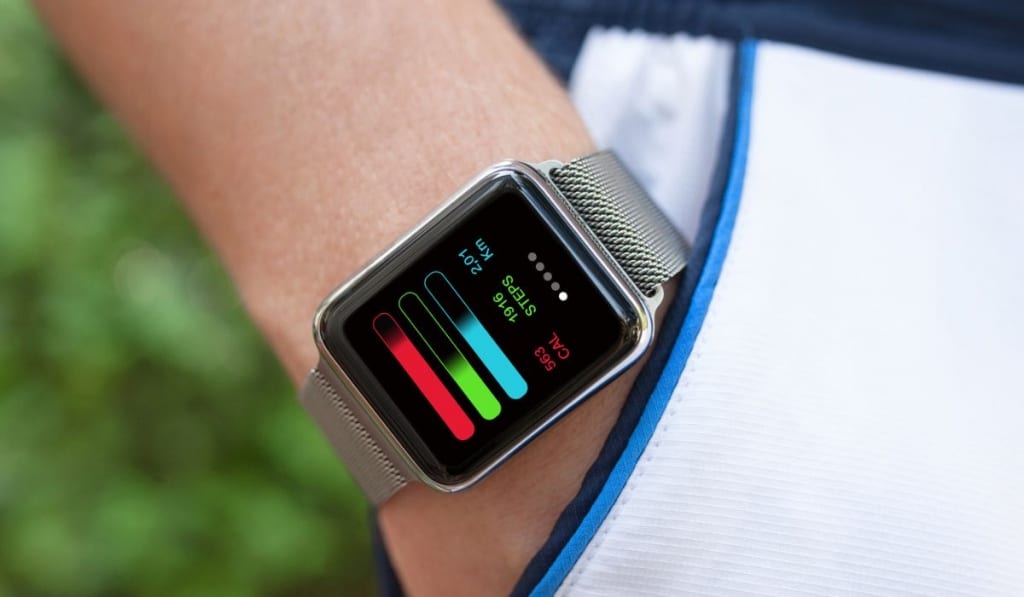The Apple Watch’s Move Calories Explained
The Apple Watch’s activity app has proven to be a reliable and effective tool for users to track their daily fitness activities. While the interface is relatively simple and easy to understand, many users find certain terms used on the app to be a bit confusing. One of those is “move calories.”
“Move” calories are calories burned from some form of physical activity that occurs while your body is in movement. Walking, cycling, cleaning, or any other activity can be counted toward your Move goal, and the Apple Watch makes this determination automatically.
Tracking move calories allows for a more realistic indication of overall calories expended as you go about your day. Let’s take a closer look at what move calories indicate and how they differ from the total calorie count on your Apple Watch.
What Are Move Calories on the Apple Watch?

The “move calories” on the Activity App shouldn’t be confused with “total calories.” They’re not the same and shouldn’t be used interchangeably.
In a nutshell, the move calories tell you how active you were throughout the day. Anything from taking a jog, walking your dog, or even walking to your fridge builds up to your daily “Move” goal.
Exercising vigorously for extended hours on a daily basis may get you a ripped physique, but most people find it unsustainable.
Unless you’re a professional athlete, your goal should be to maintain a steady level of activity throughout the day. Couple that with a minimum of 30 minutes of moderate to intense exercise and you’re bound to reach your goals.
Move calories may fluctuate drastically from day to day, because they’re based on the user’s overall activity. Setting move calorie goals can be tricky if your routine isn’t repetitive, because you perform different types of activities each day.
Move Calories vs. Total Calories: What’s the Difference?
We’ve talked about “move” — or active — calories, now let’s discuss total calories. It’s important to first understand that the human body doesn’t only burn calories when active; simply being alive requires calories.
Breathing, keeping the heart pumping, and all other bodily functions require a certain number of calories. This is known as the Basal Metabolic Rate(BMR). The number of calories required varies from person to person, and it depends on several factors like age, height, weight, and medical history.
The move calories can easily be manipulated from simply increasing daily activity levels, but the BMR remains relatively constant.
The two types combined make up the total calories burned in a day. In simple terms, calories burned while active and those burned at rest contribute towards your total calories.
The two metrics are generally used to track different goals. The move calories are more geared towards those tracking their fitness level for overall health purposes or for some type of training. However, keeping an eye on total calories is useful to anyone looking to maintain or lose weight.
What’s the Purpose of the Rings on the Apple Watch?
The rings on the activity app are a visual representation of your fitness progress throughout the day, and they’re based on the daily fitness goals you’ve set for yourself on the app.
Each ring represents a different daily milestone. You’ll often hear the phrase, “closing the ring” — it’s a term used when someone reaches their daily goals.
The Red Ring
The red ring, or the “Move” ring, tracks the number of calories you burn throughout the day. When you first set up your activity app, you’ll be required to key in your weight and height.
The watch uses this information along with sensors to determine your heart rate and ultimately estimate the calories you burn from various exercises.
The Green Ring
The green ring is also called the “Exercise” ring, and it tracks how many minutes of exercise you accomplish in a day. More accurately, it shows the duration of time in which your heart rate spiked as a result of physical exercise.
The Blue Ring
The Blue ring, also the “Stand” ring, tells you how many times you stood up for at least a minute. People who spend hours in front of a desk will find this ring particular useful.
Is the Apple Watch Accurate at Tracking Calories?
To understand how accurate the Apple Watch is at tracking calories, you first need to get a basic grasp of the concept of calories. Calories are units of energy. The term is fitting because when we consume food, we also consume energy, which is measured in calories.
To burn off those calories, we need to partake in physical activities. Certain foods provide significantly more calories than others and therefore require more physical activity to burn off.
The calories consumed fuel our bodies with energy to perform basal functions, as well as other functions. Varying amounts of energy will be allocated to different functions and activities depending on intensity and duration.
These are key factors in calorie tracking. Intensity is measured by the heart rate level, and duration is measured in minutes or hours. To accurately track calories, the Apple Watch has to be equipped with tools to measure those metrics.
The Apple Watch (on Amazon) is equipped with a reliable heart rate monitor and a timer. In addition to that, users of the watch type in their personal information with regards to weight, medical history, and height. The watch leverages all those details to accurately track how many calories you burn per minute.
How to Calculate Your Move Goal on Your Apple Watch

Setting a move goal tailored specifically to your lifestyle, health, and fitness level is the first step to ensure you always reach your goals and “close the ring.” On top of being a great fitness tool, the Apple Watch is also a motivational tool. Visualizing your daily progress motivates you to outperform yourself.
Most people set a random number as their move goal and adjust it as they go. This method may work for some, but for the most part, it wastes a lot of time.
A more practical approach is to use the Harris-Benedict formula. This formula helps you determine your total daily energy expenditure based on your BMR and how active you are on a normal day.
To calculate your Move Goal using the Harris-Benedict formula, multiply your BMR by a predetermined number specific to your level of fitness. According to this formula, the activity factor for highly active people is 1.725, while that of sedentary folks is 1.2.
To put it into perspective, if you had a BMR of 2,000 and you’re an active person, you’d multiply the two factors (2,000*1.725) to get 3,450. That wouldn’t necessarily be your Move Goal, but it will serve as your starting point.